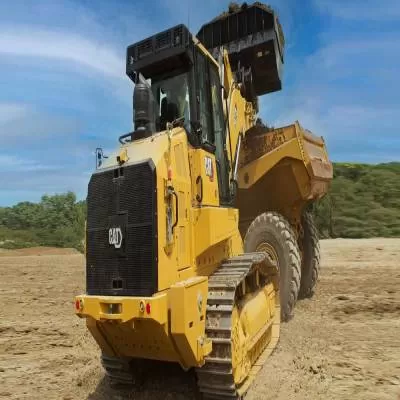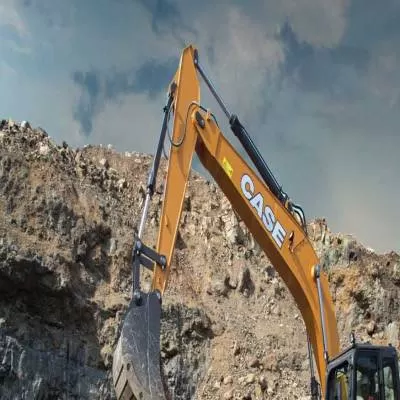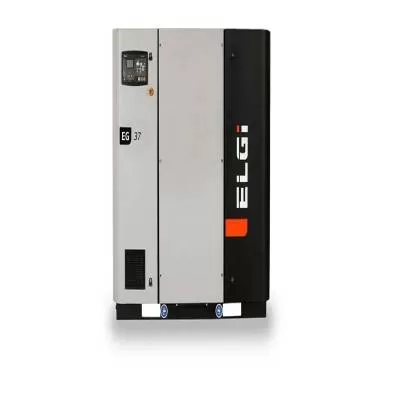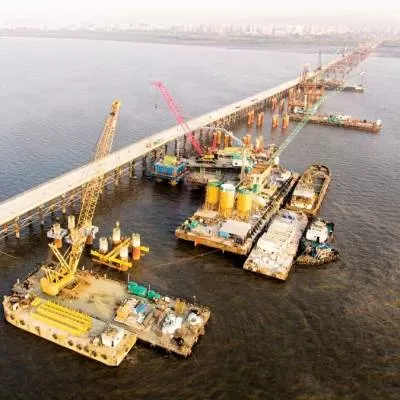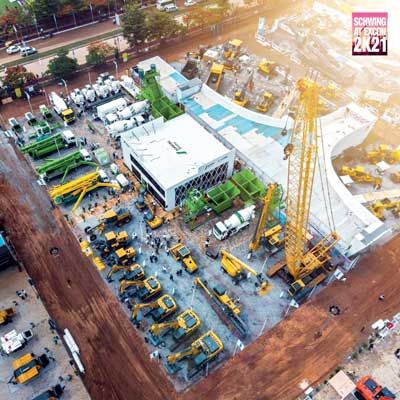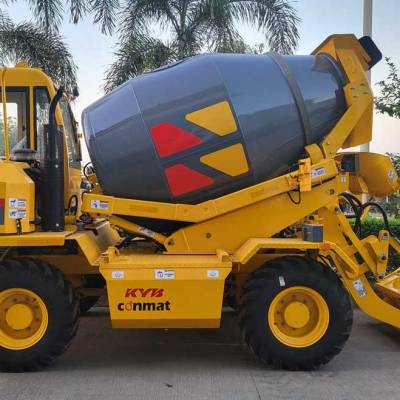
Equipment Feast
Date: December 12-15, 2016.
Venue: HUDA Ground, Gurgaon
Exhibition space: 150,000 sq m
Events with the expo:
Builder's Association of India - Managing Committee Meeting
iCEMA: Conference on Infra Redux - New and Sustainable Horizons
When the previous edition of BAUMA CONEXPO INDIA (then bc India) was held in 2014, Achche Din was the talk of the town. From then to now, change has been the only constant, with the mood more optimistic, investments increasing and a more positive progress report, especially in roads, followed by traction in railways, airports and smart cities, among others.
Exhibitions reflect industry sentiment and this is evident from the high-profile participation one can see at BAUMA CONEXPO INDIA this year. 'In 2014, the show experienced a significant slowdown as investments were low,' says Igor Palka, CEO, bC Expo India. 'There was a lot of hesitation in the market. Now, in 2016, there is optimism, which is translating to business, prospects and demand. This upswing is reflected in the exhibitor list this year.'
In 2014, 635 exhibitors and about 28,000 visitors participated at the expo. 'We will cross this number 100 per cent as we expect around 700 exhibitors and between 30,000-35,000 business visitors this year,' affirms Palka. Key equipment companies participating include ACE Construction, Kobelco, Liebherr, Linnhoff, MAN, Ammann Apollo, Schwing Stetter, Sany, Volvo, Wirtgen, Marini Fayad, Putzmeister, CAT, JCB, L&T Komatsu, TIL and XCMG.
Performance chart
Total infrastructure spending is expected to be about 10 per cent of the GDP during the Twelfth Five-Year Plan (2012-17), up from 7.6 per cent during the previous plan (2007-12). This increased impetus is attracting both domestic and international players. The private sector is emerging as a key player across various segments, from roads and communications to power and airports. 'Significant allocation to the infrastructure sector in the Twelfth Five-Year Plan and investment requirement of $1 trillion are expected to create huge demand for construction equipment in India,' says YD Murthy, Executive Vice President-Finance, NCC.
In the roads sector, the government's policy to increase private-sector participation has led to a large number of private players entering the business through the PPP model. 'As on July 31, 2016, there were 1,270 PPP projects in India, of which 658 were related to roads and bridges, accounting for a value of $670 million,' adds Murthy. 'Further, during the next five years, investment through PPP is expected to be $31 billion.' Palka agrees, saying, 'India is among the countries worldwide that have shown growth in the construction machinery market. With 55,000 machines or units about to be sold this year, this number is expected to increase to over 70,000 units by 2020; especially, demand for backhoe, excavators, mobile cranes, wheel loaders and compactors is growing. This has a positive impact on an expo like BAUMA CONEXPO.'
Going forward, much more construction machinery will be required, believes Bollineni Seenaiah, Managing Director, BSCPL. 'However, the only issue is with banks and finance companies as they have not had pleasant experiences in the last tenure, and are hence cautious about financing.' Meanwhile, Arun Sahai, COO, Ahluwalia Contracts (India), believes that with stalled projects and under-utilised equipment on site, there is sufficient equipment available with construction companies. 'Hence, immediate requirement is not growing and this surely affects the purchase market,' he points out. And, while S Ghoshdastidar, Technical Director, Simplex Infrastructures, agrees, he adds, 'Recently, the government has taken initiatives to construct new roads and improve existing ones. This has led to some improvement in demand for road construction equipment.'
What buyers want and what's in use!
Demand for construction equipment remains pretty much constant across the country, depending on volume of work. But Ghoshdastidar says, 'With the formation of Telangana, infrastructure projects have increased in both Telangana and Andhra Pradesh, necessitating more equipment.' He adds that the demand for construction of marine projects like jetties and harbours has also increased demand for equipment from the western and eastern coastal regions. Involved in activities across construction fields, Simplex Infrastructures is in possession of the most modern equipment, much of which it procured before the market slowdown. Yet, with a recent increase in activities in the housing sector, the company continues to procure tower cranes, passenger hoists, high-capacity concrete pumps, rope-suspended platforms, modern aluminium staging, shuttering systems and other small, ancillary equipment like bar-bending and cutting machines, material hoists, etc.
While Dilip Buildcon is undertaking routine road works, for which it uses equipment like graders, loaders, and excavators, Devendra Jain, Director & CEO, shares, 'For coal mining, we are planning to purchase big tippers of 19-20 cu m and big excavators of 3.2 cu m buckets, etc.'
On the other hand, with Ahluwalia Contracts (India) shifting 80 per cent of its focus on government and PSU projects, there is an increased demand for equipment. Sahai adds, 'Recently, we ordered batching plants from Schwing Stetter, concrete pumps from Putzmeister, JCB excavators and water pumps, and will soon be ordering passenger hoists for our ongoing projects.' He shares that the company also commonly requires mobile and stationary batching plants of about 30-60 cu m capacity. The company also uses excavators, hydras, etc. And for various equipment, it ensures backup generators, power backups, etc. Sahai points out, 'Other than passenger hoists, cranes are also in great demand considering high-rise towers coming up in recent projects.'
Also, NCC commonly uses construction equipment for excavation and loading, compaction and grading, drilling and blasting, lifting and erecting, mixing and paving. 'We look for innovative machines, specific to the construction of buildings, roads, mining and electrical projects,' adds Murthy.
For its part, BSCPL has big plans. With the roads sector performing well, the company is on the lookout for equipment such as crushers, mining dumpers, pavers, compactors, graders, rollers, etc. Seenaiah informs, 'In the current scenario, 10-15 per cent of the project's value is invested in equipment, which includes equipment for transportation.'
High on investment
In sourcing and procuring equipment, Dilip Buildcon applies different strategies every year. In the first two quarters of FY2016-17, Jain says, 'We have invested Rs 300 crore in purchasing equipment, and our total investment plan for the financial year is Rs 450 crore.' NCC too, for FY2017, has a CAPEX plan of Rs 100 crore for buying new equipment. And, BSCPL invests about 10 to 15 per cent of the total project cost in sourcing equipment annually.
What's more, in coming months, Simplex Infrastructures is planning to acquire tower cranes and concrete pumps for building works, a tensioner and puller for electrical transmission line projects, modern flush butt welding equipment for railway projects, tunnelling equipment and other miscellaneous earth excavation and handling equipment, among others. As for Ahluwalia Contracts (India), the company prefers buying over renting equipment. 'Investment in equipment is an ongoing process in our company,' says Sahai. 'There is always a requirement for us.'
Add-on equipment quality
In terms of machinery, the present market in India is keeping pace with international standards. Equipment commonly imported includes pavers, concrete batching plants, compactors and crushers. According to Seenaiah, complete mechanised construction equipment, especially in road construction, is in demand. 'Such equipment, previously exempted from import duty, is now taxable,' he says. 'And it will be a positive move if the government considers exempting the taxes on such equipment. He shares the example of four and six-lane highway construction, which requires complicated equipment; many manufacturers are not in a position to supply it as they face constraints in imports.
Speaking on the basic overhaul quality of any equipment, Ghoshdastidar says, 'It should be high and must perform perfectly for the purpose it has been procured. It should be able to give a reasonably long period of trouble-free service economically.' He adds that the cost of overhaul operation should be competitive with both fuel economy and reasonable maintenance cost. It should have all the required modern safety features and be operator-friendly.
Also, innovative technologies such as automation can improve quality, safety and productivity. Murthy says, 'The level of mechanisation in construction is still low compared to current technological advances, and efforts must be made to increase the mechanisation level.' Sahai agrees, saying, 'Innovation has to be taken forward by the industry as it helps attain better quality, safety for its workers, timely and speedy execution.'
Jain sees growth and good sales ahead. However, he adds, 'Equipment manufacturers have not enhanced their maintenance teams as per industry growth, as a result of which after-sales support has dropped. Manufacturers should improve on this.' While this perspective comes from the contractors, CW also connected with leading construction equipment companies, who are also exhibitors at BAUMA CONEXPO INDIA this year. Read on to know what the top-notch manufacturers have to offer...
International reach 26+ countries
- Country pavilions:
- China
- Italy
- Spain
- Germany
- USA
- Canada
Know what you need
YD Murthy, Executive Vice President-Finance, NCC, shares tips on what contractors should keep in mind while looking for equipment.
- Do your research to know what models suit your needs.
- Compare the function and efficiency of new vs. used to ensure older technology can support your needs and will not cost more to operate.
- Compare the cost of refurbished used equipment to new equipment.
- If used equipment can get the job done at a reduced lifecycle cost, buy or deploy the used machinery. If not, buying new is worth the added investment.
- HUDA Ground
- iCEMA
- BAUMA CONEXPO INDIA
- Achche Din
- Igor Palka
- bC Expo India
- ACE Construction
- Kobelco
- Liebherr
- Linnhoff
- MAN
- Ammann Apollo
- Schwing Stetter
- Sany
- Volvo
- Wirtgen
- Marini Fayad
- Putzmeister
- CAT
- JCB
- Construction Equipment
- Bollineni Seenaiah,BSCPL
- Arun Sahai
- Ahluwalia Contracts India
- S Ghoshdastidar
- Simplex Infrastructures
- Dilip Buildcon
- PSU projects
- Schwing Stetter
CW explores what's in use, what buyers are looking for, and what leading equipment manufacturers are offering at the expo this year. Date: December 12-15, 2016. Venue: HUDA Ground, Gurgaon Exhibition space: 150,000 sq m Events with the expo: Builder's Association of India - Managing Committee Meeting iCEMA: Conference on Infra Redux - New and Sustainable Horizons When the previous edition of BAUMA CONEXPO INDIA (then bc India) was held in 2014, Achche Din was the talk of the town. From then to now, change has been the only constant, with the mood more optimistic, investments increasing and a more positive progress report, especially in roads, followed by traction in railways, airports and smart cities, among others. Exhibitions reflect industry sentiment and this is evident from the high-profile participation one can see at BAUMA CONEXPO INDIA this year. 'In 2014, the show experienced a significant slowdown as investments were low,' says Igor Palka, CEO, bC Expo India. 'There was a lot of hesitation in the market. Now, in 2016, there is optimism, which is translating to business, prospects and demand. This upswing is reflected in the exhibitor list this year.' In 2014, 635 exhibitors and about 28,000 visitors participated at the expo. 'We will cross this number 100 per cent as we expect around 700 exhibitors and between 30,000-35,000 business visitors this year,' affirms Palka. Key equipment companies participating include ACE Construction, Kobelco, Liebherr, Linnhoff, MAN, Ammann Apollo, Schwing Stetter, Sany, Volvo, Wirtgen, Marini Fayad, Putzmeister, CAT, JCB, L&T Komatsu, TIL and XCMG. Performance chart Total infrastructure spending is expected to be about 10 per cent of the GDP during the Twelfth Five-Year Plan (2012-17), up from 7.6 per cent during the previous plan (2007-12). This increased impetus is attracting both domestic and international players. The private sector is emerging as a key player across various segments, from roads and communications to power and airports. 'Significant allocation to the infrastructure sector in the Twelfth Five-Year Plan and investment requirement of $1 trillion are expected to create huge demand for construction equipment in India,' says YD Murthy, Executive Vice President-Finance, NCC. In the roads sector, the government's policy to increase private-sector participation has led to a large number of private players entering the business through the PPP model. 'As on July 31, 2016, there were 1,270 PPP projects in India, of which 658 were related to roads and bridges, accounting for a value of $670 million,' adds Murthy. 'Further, during the next five years, investment through PPP is expected to be $31 billion.' Palka agrees, saying, 'India is among the countries worldwide that have shown growth in the construction machinery market. With 55,000 machines or units about to be sold this year, this number is expected to increase to over 70,000 units by 2020; especially, demand for backhoe, excavators, mobile cranes, wheel loaders and compactors is growing. This has a positive impact on an expo like BAUMA CONEXPO.' Going forward, much more construction machinery will be required, believes Bollineni Seenaiah, Managing Director, BSCPL. 'However, the only issue is with banks and finance companies as they have not had pleasant experiences in the last tenure, and are hence cautious about financing.' Meanwhile, Arun Sahai, COO, Ahluwalia Contracts (India), believes that with stalled projects and under-utilised equipment on site, there is sufficient equipment available with construction companies. 'Hence, immediate requirement is not growing and this surely affects the purchase market,' he points out. And, while S Ghoshdastidar, Technical Director, Simplex Infrastructures, agrees, he adds, 'Recently, the government has taken initiatives to construct new roads and improve existing ones. This has led to some improvement in demand for road construction equipment.' What buyers want and what's in use! Demand for construction equipment remains pretty much constant across the country, depending on volume of work. But Ghoshdastidar says, 'With the formation of Telangana, infrastructure projects have increased in both Telangana and Andhra Pradesh, necessitating more equipment.' He adds that the demand for construction of marine projects like jetties and harbours has also increased demand for equipment from the western and eastern coastal regions. Involved in activities across construction fields, Simplex Infrastructures is in possession of the most modern equipment, much of which it procured before the market slowdown. Yet, with a recent increase in activities in the housing sector, the company continues to procure tower cranes, passenger hoists, high-capacity concrete pumps, rope-suspended platforms, modern aluminium staging, shuttering systems and other small, ancillary equipment like bar-bending and cutting machines, material hoists, etc. While Dilip Buildcon is undertaking routine road works, for which it uses equipment like graders, loaders, and excavators, Devendra Jain, Director & CEO, shares, 'For coal mining, we are planning to purchase big tippers of 19-20 cu m and big excavators of 3.2 cu m buckets, etc.' On the other hand, with Ahluwalia Contracts (India) shifting 80 per cent of its focus on government and PSU projects, there is an increased demand for equipment. Sahai adds, 'Recently, we ordered batching plants from Schwing Stetter, concrete pumps from Putzmeister, JCB excavators and water pumps, and will soon be ordering passenger hoists for our ongoing projects.' He shares that the company also commonly requires mobile and stationary batching plants of about 30-60 cu m capacity. The company also uses excavators, hydras, etc. And for various equipment, it ensures backup generators, power backups, etc. Sahai points out, 'Other than passenger hoists, cranes are also in great demand considering high-rise towers coming up in recent projects.' Also, NCC commonly uses construction equipment for excavation and loading, compaction and grading, drilling and blasting, lifting and erecting, mixing and paving. 'We look for innovative machines, specific to the construction of buildings, roads, mining and electrical projects,' adds Murthy. For its part, BSCPL has big plans. With the roads sector performing well, the company is on the lookout for equipment such as crushers, mining dumpers, pavers, compactors, graders, rollers, etc. Seenaiah informs, 'In the current scenario, 10-15 per cent of the project's value is invested in equipment, which includes equipment for transportation.' High on investment In sourcing and procuring equipment, Dilip Buildcon applies different strategies every year. In the first two quarters of FY2016-17, Jain says, 'We have invested Rs 300 crore in purchasing equipment, and our total investment plan for the financial year is Rs 450 crore.' NCC too, for FY2017, has a CAPEX plan of Rs 100 crore for buying new equipment. And, BSCPL invests about 10 to 15 per cent of the total project cost in sourcing equipment annually. What's more, in coming months, Simplex Infrastructures is planning to acquire tower cranes and concrete pumps for building works, a tensioner and puller for electrical transmission line projects, modern flush butt welding equipment for railway projects, tunnelling equipment and other miscellaneous earth excavation and handling equipment, among others. As for Ahluwalia Contracts (India), the company prefers buying over renting equipment. 'Investment in equipment is an ongoing process in our company,' says Sahai. 'There is always a requirement for us.' Add-on equipment quality In terms of machinery, the present market in India is keeping pace with international standards. Equipment commonly imported includes pavers, concrete batching plants, compactors and crushers. According to Seenaiah, complete mechanised construction equipment, especially in road construction, is in demand. 'Such equipment, previously exempted from import duty, is now taxable,' he says. 'And it will be a positive move if the government considers exempting the taxes on such equipment. He shares the example of four and six-lane highway construction, which requires complicated equipment; many manufacturers are not in a position to supply it as they face constraints in imports. Speaking on the basic overhaul quality of any equipment, Ghoshdastidar says, 'It should be high and must perform perfectly for the purpose it has been procured. It should be able to give a reasonably long period of trouble-free service economically.' He adds that the cost of overhaul operation should be competitive with both fuel economy and reasonable maintenance cost. It should have all the required modern safety features and be operator-friendly. Also, innovative technologies such as automation can improve quality, safety and productivity. Murthy says, 'The level of mechanisation in construction is still low compared to current technological advances, and efforts must be made to increase the mechanisation level.' Sahai agrees, saying, 'Innovation has to be taken forward by the industry as it helps attain better quality, safety for its workers, timely and speedy execution.' Jain sees growth and good sales ahead. However, he adds, 'Equipment manufacturers have not enhanced their maintenance teams as per industry growth, as a result of which after-sales support has dropped. Manufacturers should improve on this.' While this perspective comes from the contractors, CW also connected with leading construction equipment companies, who are also exhibitors at BAUMA CONEXPO INDIA this year. Read on to know what the top-notch manufacturers have to offer... International reach 26+ countries Country pavilions: China Italy Spain Germany USA Canada Know what you need YD Murthy, Executive Vice President-Finance, NCC, shares tips on what contractors should keep in mind while looking for equipment. Do your research to know what models suit your needs. Compare the function and efficiency of new vs. used to ensure older technology can support your needs and will not cost more to operate. Compare the cost of refurbished used equipment to new equipment. If used equipment can get the job done at a reduced lifecycle cost, buy or deploy the used machinery. If not, buying new is worth the added investment.


